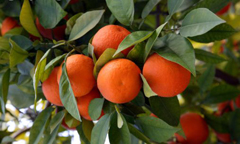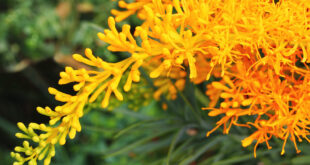A is for Apple, the fruit of autumn that grows on trees and is delicious fresh, in pies, or as cider.
B is for Blueberry, that are indeed berries which are blue and grow on bushes both low and high.
C is for Cranberry, the tart red fruit that is grown in bogs and made into juice or a jellied sauce.
D is for Date, the sweet fruit that grows up near the top of date palm trees.
E is for Elderberry, which grows on shrubs and is used to make wines, cordials, and marmalade.
F is for Fig, which grow on the small Ficus carica tree.
G is for Grapes, which grow on vines and can be eaten fresh or made into wine.
H is for Honeydew Melon, which are sweet green melons that grow on vines.
I is for Inedible, which some fruits are including Holly, Mistletoe, Privet, and, Wahoo. 
J is for Jam, which can be made from the pulp and juice of many fruits including strawberries and blueberries.
K is for Kiwifruit, which are the bright green berry from woody Actinidia deliciosa vines.
L is for Lemon and Lime, which are both acidic citrus fruits used to flavor many foods.
M is for Mango, a fruit with bright orange flesh that is grown on trees in tropical regions.
N is for Nectarine, which is actually a cultivar of Peach without the fuzzy skin. 
O is for Orange, the citrus with varieties like navel for eating and Valencia for making juice.
P is for Peach, the sweet yellow and red fruit of summer that gives the state of Georgia it's nickname.
Q is for Quince, which grown on trees and generally must be cooked before eaten.
R is for Raspberry, the delicate red berry that grows on prickley vines.
S is for Strawberry, the red fruit of early summer that grow on small plants with runners.
T is for Tangerine, the small bright orange sweet citrus with thin easily peeled skin.
U is for Ugli Fruit, which is a tangelo hybrid grown in Jamacia.
V is for Vinegar, which is often made from apples or grapes.
W is for Watermelon, the large green melons of summer with bright sweet red flesh.
X is for X, as in cross, where two fruit varieties are bred together in hopes of making a better fruit.
Y is for Yangmei, a fruit native to China that is eaten fresh, dried, canned, fermented, or in juice.
Z is for Zest, which are strips of citrus peel used in preparing a variety of foods and drinks.









zebra - 15 years ago
Our tamarillo tree has a problem. The under side of all the leaves is covered with small brown specks that look like mites of some sort and the leaves are dying off. HAve sprayed with Mavrick but does not have any effect. Can anyone tell me what the problem is and how to treat it?